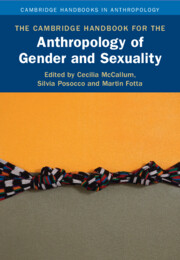Book contents
- The Cambridge Handbook for the Anthropology of Gender and Sexuality
- Cambridge Handbooks in Anthropology
- The Cambridge Handbook for the Anthropology of Gender and Sexuality
- Copyright page
- Contents
- Contributors
- 1 Introduction to The Cambridge Handbook for the Anthropology of Gender and Sexuality
- Part One Openings and Orientations
- 2 Remixing Feminist Epistemology and Methodology
- 3 Critical Ethnography as a Collective Feminist Project
- 4 Kinship and Relatedness as Vital Lens
- 5 Reframing the Social, Rethinking the Body, Confronting Biologism
- Part Two Knowledges and Domains
- Part Three Resistances and Intersections
- Part Four Desires and Relations
- Part Five Recursivities and Futures
- Name Index
- Subject Index
- References
4 - Kinship and Relatedness as Vital Lens
from Part One - Openings and Orientations
Published online by Cambridge University Press: 29 September 2023
- The Cambridge Handbook for the Anthropology of Gender and Sexuality
- Cambridge Handbooks in Anthropology
- The Cambridge Handbook for the Anthropology of Gender and Sexuality
- Copyright page
- Contents
- Contributors
- 1 Introduction to The Cambridge Handbook for the Anthropology of Gender and Sexuality
- Part One Openings and Orientations
- 2 Remixing Feminist Epistemology and Methodology
- 3 Critical Ethnography as a Collective Feminist Project
- 4 Kinship and Relatedness as Vital Lens
- 5 Reframing the Social, Rethinking the Body, Confronting Biologism
- Part Two Knowledges and Domains
- Part Three Resistances and Intersections
- Part Four Desires and Relations
- Part Five Recursivities and Futures
- Name Index
- Subject Index
- References
Summary
Focusing on key themes, this chapter highlights how kinship and relatedness constitute a vital lens for understanding gender. First, the everyday is the principal ground for examining relatedness. It illumines how gender shapes our lives and is, in turn, formed, maintained, and altered over time. The borders between gender and other aspects of life can be porous. Second, the seemingly merely domestic or intimate can be generative – a theme that builds on earlier feminist insights. Kinship has wider consequences, including for politics or economics. Finally, kinship is imbued with the potential for hierarchy and inequality, ambivalence, ruptures, and failure. Its generativity includes its less amiable aspects. Gendered inequities and enmities arise from these aspects. Breaks in the fabric of kinship, however, imply the possibility of repair, which may depend on gendered forms of labor. Threading through these themes is care, a key aspect of everyday life and relatedness alike. Care encompasses whole economies and traverses national borders. Care speaks, too, to the vulnerability that is at the heart of what it means to be human. It mirrors, and at times heightens, the difficulties inherent in kinship.
Keywords
- Type
- Chapter
- Information
- Publisher: Cambridge University PressPrint publication year: 2023



